Thinking Backwards
The great ball court at Chichen-Itza is quiet in the hot sun.
The clicking of Japanese cameras, the clapping of tour guides
raising an echo, and the flicker of an iguana moving in the rubble,
barely stirs the millennial silence. High up on the two long facing
walls, vertical stone rings stand out at right angles from the
limestone facades. In the ritual games, teams contended to kick
a large, hard rubber ball through these hoops, they say. The losers
were ceremonially killed. Or was it the winners?
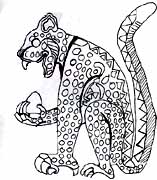
Peggy Sketch
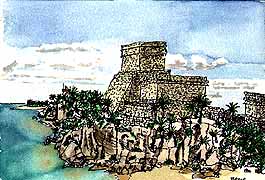
Tulum
For all our archeology, we don't know much about Mayan civilization,
really. Chichen-Itza flourished around the year 1000AD, but most
of the Mayan cities were swallowed in jungle before the second
millennium was barely started. There are still Mayan Indians throughout
the Yucatan, but waves of conquest have silenced history. The
hawkers selling ersatz artifacts at the gate are only interested
in dollars.
We went down to the Yucatan over Christmas to meet Seth, after
his sojourn in Belize, thinking that standing among thousand year
old ruins might ease us of the daily complaint. Seth had his hammock
hung in a cabana on the beach at Tulum, within sight of the Mayan
temple ruins there. He'd gotten us a room in a low rent hotel
on the main drag, three pot-holed miles from the sand.
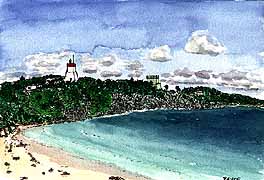
Reverse View
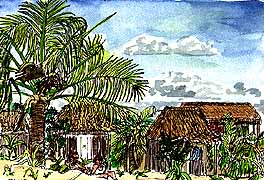
Seth & Peggy on Beach
The scene on the beach was pagan enough. Scads of world youth
with their clothes off, beating drums, and snorkeling on a dying
reef. The longest barrier reef in the hemisphere. Seth had been
diving on it farther south with his field ecology team, and was
saddened by the unraveling of the threads. Now he was soaking
the bennies on these coral sands, recuperating with a broken collarbone
after an incident in a bar in Punta Gorda. Peggy and I felt like
ancient history among the topless babes and athletic dudes.
I'd expected to get an intuitive charge in the old sacred quadrants.
Pursuing a scheme to sculpt main currents in the American mythos,
I hoped to touch the sources of the Corn Peoples. The earliest
maize material was found in the Tehuacan Valley, dating back to
5500BC, and it was the Mayans who selectively bred corn until
it could support a civilization. Maybe the corn carriers left
traces among these ruins. If so, I couldn't sense them. Even in
the press of gawking tourists, my strongest impression was of
emptiness. A hollow silence from which the spirit had flown.
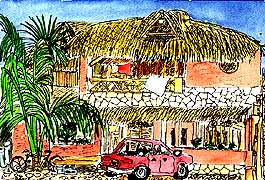
Hotel Italiano
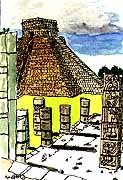
Chichen-Itza
At Chichen-Itza Seth lay down in the sun on the grand plaza and
slept, while Peggy sketched hieroglyphs, and I found a perch from
which to paint the great pyramid. A bit of shade, a place to sit,
a piece of foreground. I was soon surrounded by a gaggle of Italian
tourists watching the hand-eye exercise. Do all the tourists wonder,
as I do, why we make these pilgrimages? Were they looking over
my shoulder for an answer? What does it mean, this manhill in
the jungle? When Seth woke, he reported having weird dreams.
History is a weird dream. A thousand years ago men were piling
up monuments to the great mystery. Peggy and I have spent time
at some of them in recent years. For seven months in 1990 we lived
in the medieval city of Norwich, thanks to a Fulbright teacher
exchange. Living in what was once a weaver's cottage, over an
old Saxon well. Every day I walked the city precincts trying to
dowse ley lines, and intuit the old processional way from the
cathedral. Where did the city patron, George, pursue the dragon
on his Saint's Day? Even in the hubbub of a modern English city,
there are openings into other times, although sorting intuitions
from imaginings is a fool's errand. Just the job for me.
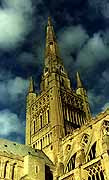
Norwich Cathedral

Walking, photographing, drawing, reading Grail legends and Arthurian
romances in the cathedral close, I began to sense an holistic,
geomantic landscape. I kept encountering the same itinerant painter,
invariably setup in the very vantage I had followed a trace to.
I finally asked him, half joking, "Are you painting the ley lines?"
Without a blink, he replied, "That's where all the good views
are." But they were just glimpses for me, and I wondered what
it was that had me perusing this old ground, with an eye turned
inward. Some years later I discovered that my grandmother's people,
named George, who arrived in New England in the early 1700s, originally
came from Norwich. Maybe it was a genetic memory I was chasing.
The memory I carried away from Norwich was of a soaring cathedral,
aligned with the light, set in an invisible web which under-weaves
the landscape. Although the Christian symbolism rose up to exalt
a celestial deity, man risen to God, there were still Greenmen
on the bosses, pagan vestiges on the facade. The whole ethos of
sacred space aligned with the spirit of place permeated the old
city. While the troubadours sang of romantic love, and a grail
quest, the peasants still paraded Old Snap, and dropped wishes
in the well.
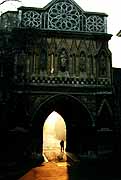
St. Ethelbert's Gate
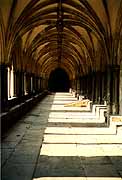
Cloisters
The cut Caen stone for Norwich Cathedral was barged from France
to this muddy meadow by the Wensum. One day I twitted the workmen
doing restoration work in the cloisters. "Aren't you afraid that
you'll mess up the symbolism and something horrible will happen?"
A young mason came down from where he was repainting a boss, and
said, "My father was a mason, and his before him, and so on. They're
all buried over there." He pointed into the cloister green. "And
they knew a trick or two. You ever think about what this cathedral
is built on?" I said, no, but it looked like clay. "Ever know
a building to sit square on clay, for even a few years, let alone
a thousand?" I had to admit it wasn't likely. "Ah," he said, lifting
a finger, "First they laid down a bed of feathers, so the building
could fly." His partner exploded in laughter.
We've forgotten the little magics, and much of the vulgar symbolism
in the carved details. Scholars are now rediscovering a sacred
geometry architected into the great cathedrals. In our ascent
to ever more rarified abstractions we forget how four-square and
down to earth people once were.
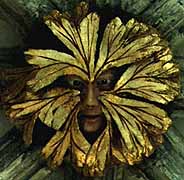
Greenman Boss
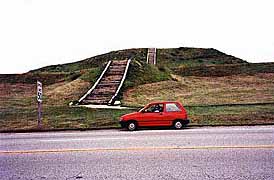
The Owl at Cahokia
Back on our own turf, Peggy and I took a sabbatical drive around
this country in 1996-97, chasing American history and a sense
of symbolic geography. More by chance than design we encountered
the Mississippian culture. The great earthen pyramid builders
of the first millennium. We stumbled upon Cahokia, that extraordinary
earthwork metropolis in the American Bottom.
Isn't it astonishing that we never learned about Cahokia in US
History, or AmerIndian Ethnology? A thousand years ago, in what
is now East St. Louis, there was an Indian civilization centered
on a city of 20,000, which influenced all the peoples of the American
heartland. From Florida to Oklahoma, from the Gulf to the Great
Lakes, artifacts have revealed a Mississippian culture in full
flower at 1000AD. We made pilgrimage to sites all over the South
and Mid-West. Our lessons had taught us the American Indians were
nomadic hunter gatherers without pots to piss in. What a convenient
myth for a manifest destiny.
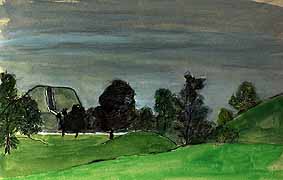
Bryce's Cahokia
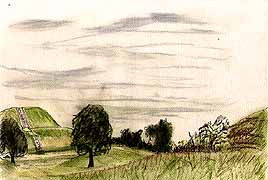
Peggy's Cahokia
The big "mound" at Cahokia covers 14 acres, and is 100 feet tall.
Around it are the remains of more than 100 other earthworks, slowly
giving up their secrets to archeologists. Although early travelers
reported on the numerous mounds they saw near the rivers, the
earthworks were treated more as nuisance anomalies, to be bulldozed
away and forgotten. Even though DeSoto had wintered in one of
the last Mississippian towns, at Natchez, it was more convenient
to forget. To call the natives savages, and ignore their works.
Now archeologists believe the works at Cahokia were aligned to
the stars, and the seasonal turnings of the sun. A bird-man and
a solar chief head the iconography. An immense plaza was leveled
with clay for ritual games of "chunkey", where spears were thrown
at rolling disks of stone. Celestial alignments were marked out
in huge "woodhenges", and a variety of ceremonial earthworks were
engineered (with sophisticated interior drainage), over a relatively
brief span of years.

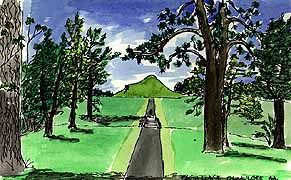
Earth Lodge at Ocmulgee, Georgia
The Mississippian culture was founded on corn, a tropical grain,
selected for increasing cold resistance as it was passed along
from people to people. Corn transformed nomadic North America,
and the first Europeans settled on corn fields their imported
diseases had depopulated. By then Cahokia had been abandoned.
The Mississippians, like the Mayans, had become little peoples
again. Dispersed by cultural upheavals we can only surmise upon.
Ecological collapse, due to cooling temperatures, rising water
levels, or soil exhaustion? Conquest by more warlike hunter gathers?
Indigenous disease? Or merely a cultural evolution back to dispersed,
less authoritarian, communities? We don't know.
We do know that a thousand years ago peoples in Mexico and the
American Bottom and East Anglia were celebrating the connection
between the mundane and the divine with stupendous works. The
mortared rubble pyramids of the Maya, faced with limestone carvings,
now show their crumbling interiors. Those "mounds" that are left
in East St. Louis, are covered with grass and trees. And the carvings
on Norwich Cathedral are dissolving in the acid rain. But they
are still turned to a sacred geography. Still point to the stars
and solstices.
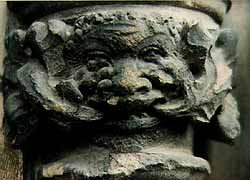
Acid Rain
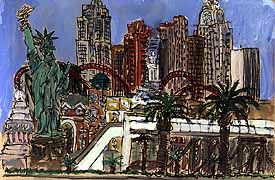
NY,NY at Vegas
We're putting up some pretty remarkable monuments, ourselves.
How long they'll last, is a question, of course. We may find out
about ecological disaster, or cultural implosion. But it's a rare
edifice these days, which symbolizes the divine in man, or the
link between earth and sky. The higher religions, which look for
a light within, seem to have forsaken the light without. Man is
reduced to happenstance in a blind cosmos, or elevated beyond
his material being. There is no sacred landscape. If we face a
house south, it's for solar tempering. We don't frame a window
to the east for rebirth, or one to the west for our soul's passage.
The artisans of 1000AD, at Chichen-Itza, and Cahokia, and Norwich,
weren't glorifying their individual artistry. They were each holding
up a small mirror, so man could see himself in the cosmos, and
the cosmos could show itself in man. Every artist was steeped
in a language of sacred symbols everyone understood. A culture's
tales were told in an inner vocabulary. We can barely begin to
think that way.
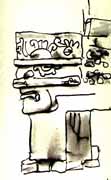
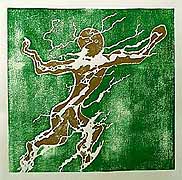
Dancing Sagadahoc
But it's worth a try. This place we live, by Merrymeeting Bay,
is at a confluence of many waters. Rivers that rise in the White
Mountains flow down the Androscoggin, to meet the waters from
Moosehead, and the central uplands of Maine, which run in the
Kennebec. Four local rivers join them here in Bowdoinham, waters
rising with the tide up the Sagadahoc, and swirling like a maelstrom
out The Chops. This convergence is an emblem of the American experiment.
Diverse cultural streams spiraling together in a noisy tiderace.
And, because each of us must now create his own religion, find
his own sacred symbols, make his own piece with the landscape,
I'll start here, at the center of the universe, where all the
waters meet.
The Corn Peoples sanctified their places by acts of will. Carving
petroglyphs, marking precincts, building pyramids, situating their
dwellings to the sacred directions, enacting rituals. There is
no divine in the landscape unless we see it there. Act it out.
That's part of heaven's deal with man. So it's up to us to put
the sacred back in the woodlot.
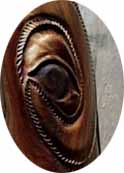
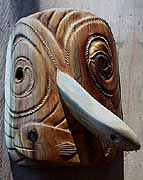
Weird
Looking for symbols to reenchant this place after the millennium,
I thought about Weird Eddy. He's the water Coyote. The one who
blows your hat off, and spins your boat around. A spirit of confluences.
Playful and dangerous, like many trickster deities. I decided
to make his mask. Start at the swirling center.
Roughed out a cedar blank, to find two knotholes exposed. One
about right for an eye, but the other, smaller one, somewhere
near his mouth. I imagined some sort of spiral motif, maybe with
the twisted nose of an Iroquois false face. Sketching on the wood
I suddenly saw a spiral rising from the eye and resolving into
an eel, with the other knot for its eye. The Bay is full of eels,
so that fit. Then a counter-spiraling eel entangled. At this point
Seth and an artist friend barged into the shop. Why don't you
make his nose come right out of the mask, they proposed. And the
second eel broke surface.
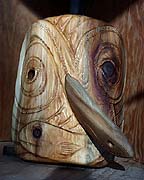
Eddy